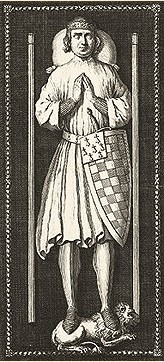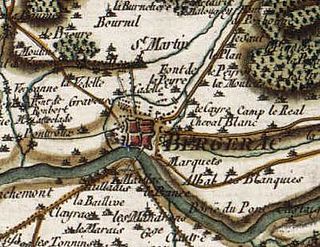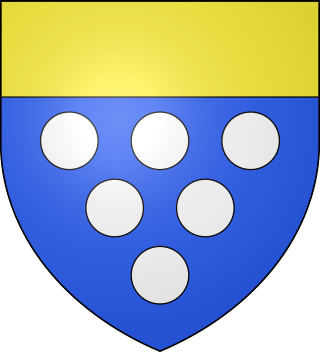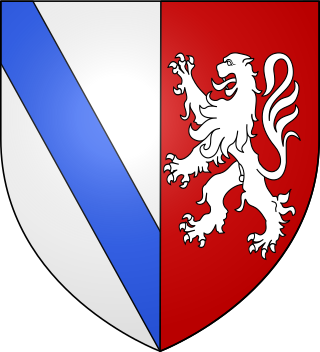Related Research Articles

Arthur II, of the House of Dreux, was Duke of Brittany from 1305 to his death. He was the first son of John II and Beatrice, daughter of Henry III of England and Eleanor of Provence.

The Comminges is an ancient region of southern France in the foothills of the Pyrenees, corresponding approximately to the arrondissement of Saint-Gaudens in the department of Haute-Garonne. This region is normally associated with the former domain of the Counts of Comminges, although earlier definitions are based on the Diocese of Comminges or the territory of the Convenae.
The Battle of Auberoche was fought on 21 October 1345 during the Gascon campaign of 1345 between an Anglo-Gascon force of 1,200 men under Henry, Earl of Derby, and a French army of 7,000 commanded by Louis of Poitiers. It was fought at the village of Auberoche near Périgueux in northern Aquitaine. At the time, Gascony was a territory of the English Crown and the "English" army included a large proportion of native Gascons. The battle resulted in a heavy defeat for the French, who suffered very high casualties, with their leaders killed or captured.
L'Isle-Jourdain was a lordship and then county near Gers in Gascony during the High Middle Ages. It took its name, Jourdain, from its crusading baron who was baptised in the River Jordan on the First Crusade. Its last count sold the fief to the King of France.
Jordan IV was the Lord of L'Isle-Jourdain and a vassal of Alfonso of Poitou. He was a crusader during the Italian crusades of Guelph against Ghibelline. His son-in-law was Aimery IV of Narbonne, who led the armies of Florence and Anjou in the Battle of Campaldino in 1289 and his brother was the provost of Toulouse.
BernardIV Jordan was the Lord of L'Isle-Jourdain from 1303 or 1304 to his death. He was the son and successor of Jordan IV and his first wife Faidiva. Bernard Jordan maintained an alliance with Gaston I of Foix.

John I of Armagnac, son of Bernard VI and Cecilia Rodez, was Count of Armagnac from 1319 to 1373. In addition to Armagnac he controlled territory in Quercy, Rouergue and Gévaudan. He was the count who initiated the 14th century expansion of the county.

The Battle of Bergerac was fought between Anglo-Gascon and French forces at the town of Bergerac, Gascony, in August 1345 during the Hundred Years' War. In early 1345 Edward III of England decided to launch a major attack on the French from the north, while sending smaller forces to Brittany and Gascony, the latter being both economically important to the English war effort and the proximate cause of the war. The French focused on the threat to northern France, leaving comparatively small forces in the south-west.

Archambaud de Grailly was Viscount of Castillon and Gruson from 1356 until his death, and from 1369 Count of Bénauges and Captal de Buch. He was the younger son of Peter II of Grailly and his wife, Rosamburge of Périgord and was Count of Foix by his marriage to Isabella, Countess of Foix.

Gaston I de Foix-Grailly was from 1412 to 1451 Captal de Buch, Count of Bénauges, and Viscount Castillon. He was a Knight of the Order of the Garter from 1438. Gaston was the second son and heir of Archambaud de Grailly and his wife, Isabella, Countess of Foix.

The Gascon campaign of 1345 was conducted by Henry, Earl of Derby, as part of the Hundred Years' War. The whirlwind campaign took place between August and November 1345 in Gascony, an English-controlled territory in south-west France. Derby, commanding an Anglo-Gascon force, oversaw the first successful English land campaign of the war. He twice defeated large French armies in battle, taking many noble and knightly prisoners. They were ransomed by their captors, greatly enriching Derby and his soldiers in the process. Following this campaign, morale and prestige swung England's way in the border region between English-occupied Gascony and French-ruled territory, providing an influx of taxes and recruits for the English armies. As a result, France's ability to raise tax money and troops from the region was much reduced.

Louis I de Poitiers, Count of Valentinois, was a 14th-century French noble. Louis was killed during the Battle of Auberoche in 1345.

The siege of Aiguillon, an episode in the Hundred Years' War, began on 1 April 1346 when a French army commanded by John, Duke of Normandy, laid siege to the Gascon town of Aiguillon. The town was defended by an Anglo-Gascon army under Ralph, Earl of Stafford.

Lancaster's chevauchée of 1346 was a series of offensives directed by Henry, Earl of Lancaster, in southwestern France during autumn 1346, as a part of the Hundred Years' War.

Gaillard I de Durfort, known as the Archdeacon (l'Archidiacre), was a French priest and nobleman of the Durfort family. He inherited the Lacour–Durfort lands in 1345 and abandoned his clerical career to marry Marguerite de Caumont.

Amaury IV of Craon, Lord of Craon, Chantocé, Ingrandes, Briollé, Châteauneuf-sur-Sarthe, Précigné and Sablé, Sainte-Maure, Nouâtre, Pressigny and Marcillac, Châteauneuf-sur-Charente and Jarnac, was a French noble, who was part of the Hundred Years' War.
Alixandre de Caumont, also known as Anissant III de Caumont, Lord of Sainte Bazeille was a 14th century French noble.

The Black Prince's chevauchée, also known as the grande chevauchée, was a large-scale mounted raid carried out by an Anglo-Gascon force under the command of Edward, the Black Prince, between 5 October and 2 December 1355 as a part of the Hundred Years' War. John, Count of Armagnac, who commanded the local French forces, avoided battle, and there was little fighting during the campaign.

Margaret of Béarn – also known as Margaret or Margueriteof Montcada was a noblewoman, who ruled lands near the Pyrenees mountains and in the southwestern part of present-day France. When her father died in 1290, she inherited the lands, assets and title, Viscountess of Béarn. In 1310 following the death of her sister, she inherited the assets and title of Countess of Bigorre.

English offensives in 1345–1347, during the Hundred Years' War, resulted in repeated defeats of the French, the loss or devastation of much French territory and the capture by the English of the port of Calais. The war had broken out in 1337 and flared up in 1340 when the king of England, Edward III, laid claim to the French crown and campaigned in northern France. There was then a lull in the major hostilities, although much small-scale fighting continued.
References
- Sumption, Jonathan (1990). Trial by Battle. London: Faber and Faber. ISBN 978-0571200955.